African Owl Pigeon: History And Breed Guide
Many people think of pigeons as racers or messengers. They seem to be birds with robust features that survive in the harsh urban wilderness. However, there are some pigeons solely raised for their beauty.
The African Owl Pigeon is such a fancy breed.
An aesthetically pleasing head, bold eyes and short beak create the characteristic appearance of the African Owl Pigeon. They make beautiful and exotic pets. The breed is a major attraction at bird shows and exhibitions and is popular with pigeon enthusiasts.
Have you been thinking about raising an African Owl Pigeon?
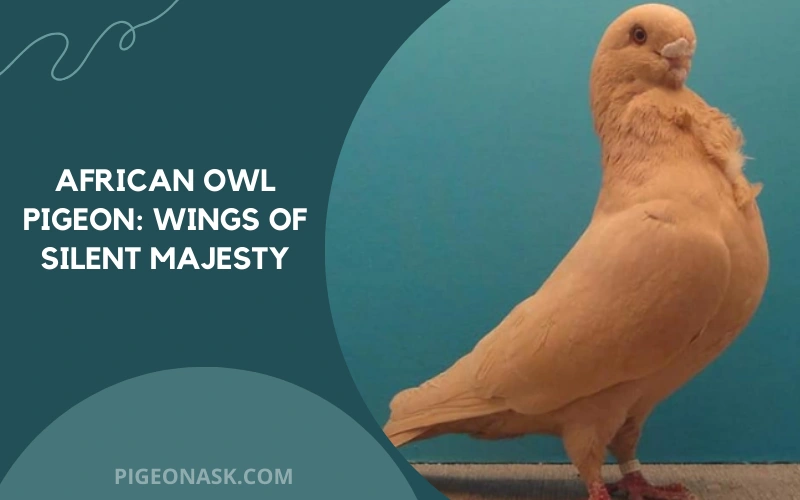
Although more challenging than keeping usual pigeons, it can be quite rewarding. You will find the necessary guidelines in the following discussion.
African Owl Pigeon Profile
| Name | African Owl Pigeon |
|---|---|
| Scientific Name: | Columba livia |
| Common Names: | African Owl, Foreign Owl, English Owl |
| Origin: | Tunisia, Africa |
| Size: | 20 cm tall, Average-sized breed |
| Weight: | 8-12 ounces |
| Lifespan: | 15 years captivity |
| Temperament: | Calm and docile |
| Behavior: | Obedient and easy to tame |
| Special Features: | 01. Jabot- a crest of feathers that runs down the owl pigeon’s chest. 02. Short, stout owl-like beak. |
| Breeding and Maintenance: | 01. Requires dry, spacious homes with lots of sunlight. 02. Eats standard pigeon feed. 03. 2-4 broods per year. |
| Common or Popular Varieties: | The African owl itself is a variety of pigeon breeds. |
Interested in similar topics on pigeon breed:
Overview
The African Owl Pigeon is one of the most aesthetically pleasing pigeon breeds. It has a puffed chest and confident posture, adding more to its elegance.
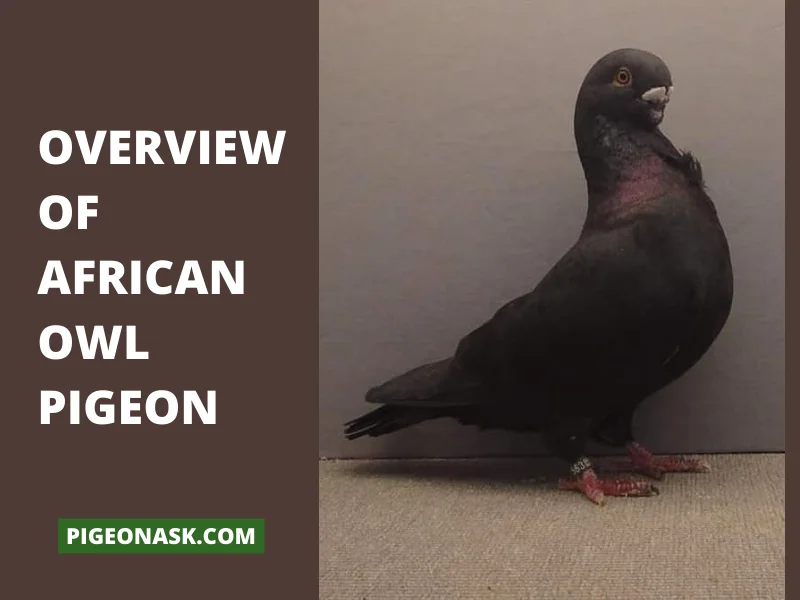
They don’t have a pointy beak like the common feral pigeon. Plus, their head tends to have a more perfectly rounded shape.
The pigeon’s eyes are also more prominent and bolder. Such resemblances helped this pigeon acquire the ‘Owl’ in its name.
People keep these pigeons mainly as fancy pets. They are a major exhibit in pigeon shows. Being sensitive and timid creatures, these pigeons require a lot of care and attention from their owners.
History and Origins of African Owl Pigeons
Like most modern pigeons, the origin of the African Owl can be traced back to the wild rock dove. However, the African Owl Pigeon itself didn’t originate in the wild. Instead, they emerged from years of careful and selective breeding.
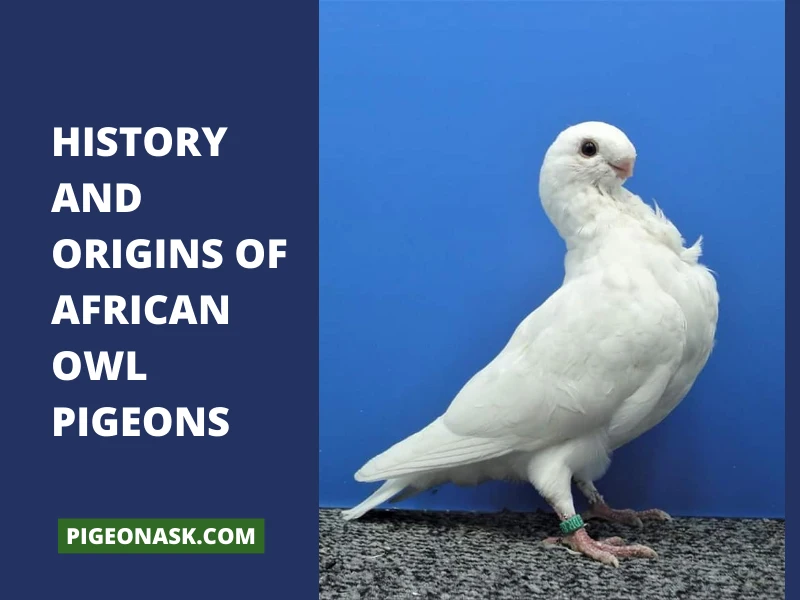
As it’s pretty apparent from the name, the African Owl Pigeon first appeared in Tunisia, Africa.
Their beauty and elegance drove pigeon enthusiasts to bring these birds to Europe. Around the 19th century, they came to England, where people called them ‘Foreign Owls’.
It didn’t take them long to win the hearts of English pigeon lovers with their aesthetic beauty. Gradually, they made their way into the home of American pigeon enthusiasts and other parts of the world.
Physical Characteristics and Features
The African Owl Pigeon’s distinct physical characteristics make it stand out from other breeds. These features limit some of their sports abilities but are also the reason for their popularity.
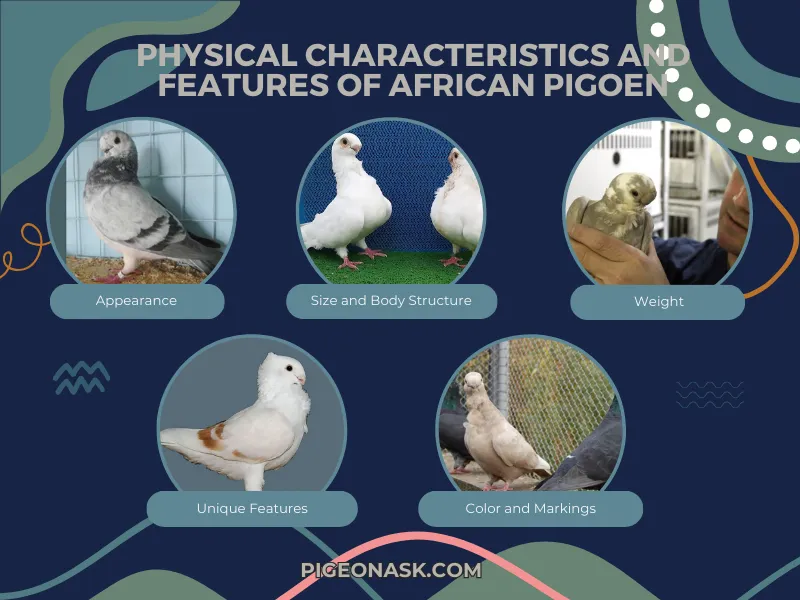
Appearance
The African Owl Pigeon’s ball-shaped head and owlish beak are the breed’s trademark. It stands upright and struts with a strong chest-out posture. Their bold red eyes are calm and expressive.
Size and body Structure
These pigeons aren’t exclusively a tiny or large-sized breed. Like most other average-sized pigeon breeds, they stand around 8 inches tall. However, the African Owls’ comparatively plump bodies make them look short.
Weight
The African Owl Pigeon weighs the same as any average pigeon. Depending on the diet and upbringing, there can be slight variations in weight. However, you can expect most African Owl Pigeons to be around 200-250 grams.
Unique Features
Their owlish head and beak are undoubtedly the most unique thing about this pigeon. They also have a graceful fluff of feathers on the chest (known as Jabot).
Another notable feature is their fan-shaped tail. It helps the pigeon with flight, display and balance.
Colors and Markings
These pigeons come in various colors and patterns. Commonly, they are black, white, silver, blue, brown, khaki, almond, grizzle, etc. Their beaks might be solid color or patterned.
Distribution And Habitat
If you raise African Owl Pigeons, learning about their habitat and distribution is essential. Remember, these pigeons are extra sensitive about dampness and cold. So, the breeder must ensure a dry and naturally warm environment for the pigeons.
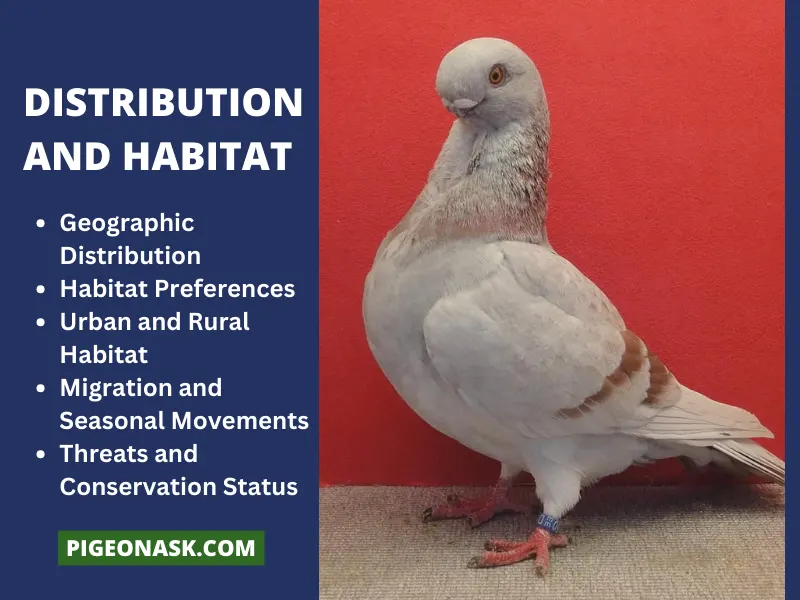
Although these pigeons are from Africa (where damp and wet is common), they are a fancy breed and have been raised for many years in dry, domestic, and captive conditions. So, their immune system isn’t robust like wild birds.
Geographic Distribution
As already mentioned, the African Owl Pigeon first appeared in Africa. After being imported to England, it gradually gained international popularity. Today, you can expect to find it in a pigeon enthusiast’s home in any corner of the world.
Habitat Preferences
These pigeons are exclusively domesticated birds. So, they’re unlikely to survive in the wild. They prefer dry, well-ventilated lofts and cages with much space and sunlight.
The birds will catch respiratory infections if you put them in a damp, dark place. Clean the loft regularly and ensure plenty of sunlight entry. Try to maintain a temperature of 65-70F in the pigeon’s home.
Urban and Rural Habitat
As long as you provide them with the ideal conditions, the African Owl Pigeon can thrive in urban and rural settings. You can build their lofts in parks, farms, gardens and rooftops.
Migration and Seasonal Movements
Being a domestic bird, the African Owl Pigeon doesn’t have to migrate. They stay in their lofts throughout the year.
Threats and Conservation Status
These pigeons aren’t an endangered species since many pigeon enthusiasts adore and breed them. A damp environment and lack of natural sunlight are two main threats to this breed.
Behavior And Traits of African Owl Pigeons
The behavioral traits of African Owl Pigeons can be quite different from other breeds. They are calm and gentle birds who don’t create or like disturbance –
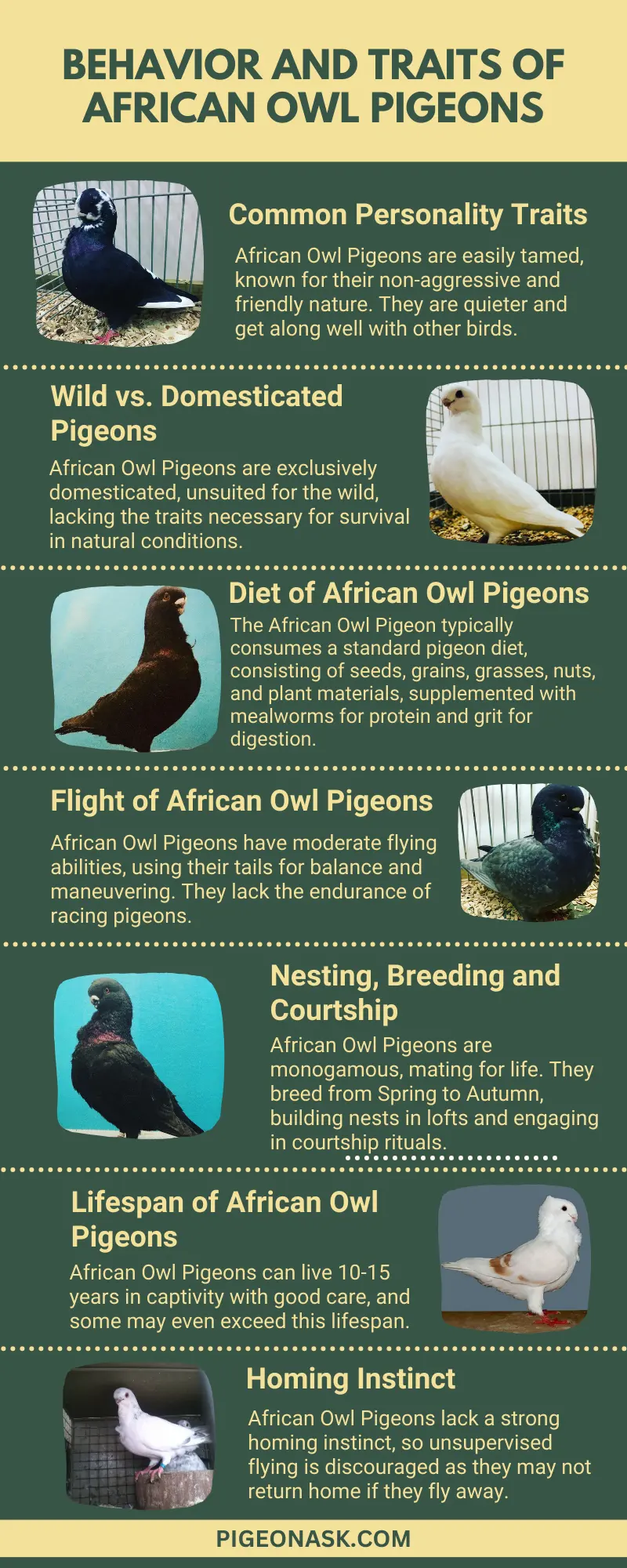
Common Personality Traits
The African Owl Pigeon is one of the easiest breeds to tame. They are non-aggressive, friendly and get along well with other birds. You will find these birds gentle and less noisy than other pigeons.
Wild vs. Domesticated Pigeons
You are unlikely to find them in the wild as they wouldn’t survive in those conditions long. They are an exclusively domesticated breed and don’t possess the traits to live in the wilderness.
Diet
The African Owl Pigeon prefers a standard pigeon diet. So, you can feed it seeds, grains, grasses, nuts and other plant materials pigeons usually eat.
Incorporating some mealworms can help with their protein requirement. Meanwhile, grit can help with their digestion.
Flight
The African Owl Pigeon has decent flying ability. They use their tail for balance and steering in mid-air. You can train them to perform various aerial acrobatics.
However, they don’t possess the flight strength or stamina of racing pigeons.
Nesting, Breeding and Courtship
These pigeons, like all other pigeons’ mate for life. Their breeding season is from Spring to Autumn.
During this period, they would build a nest inside the provided lofts with twigs, branches and straws. The male displays its plumage and Jabot and offers food to court the female.
Lifespan
With proper maintenance and unaffected by diseases, an African Owl Pigeon can live 10-15 years in captivity. Some birds might survive even longer than that.
Homing Instinct
Unlike race pigeons, the African Owl Pigeon doesn’t have a strong homing instinct. If these pigeons fly away, they are unlikely to find their way back home, and you might lose them. So, unsupervised flying is not recommended for these birds.
Breeding And Maintenance
The African Owl Pigeon can have 2-4 four broods per year. There will be two eggs in each brood. Consider that a well-grown African Owl Pigeon sells for 250$ (and more). So, breeding these birds can be rewarding.
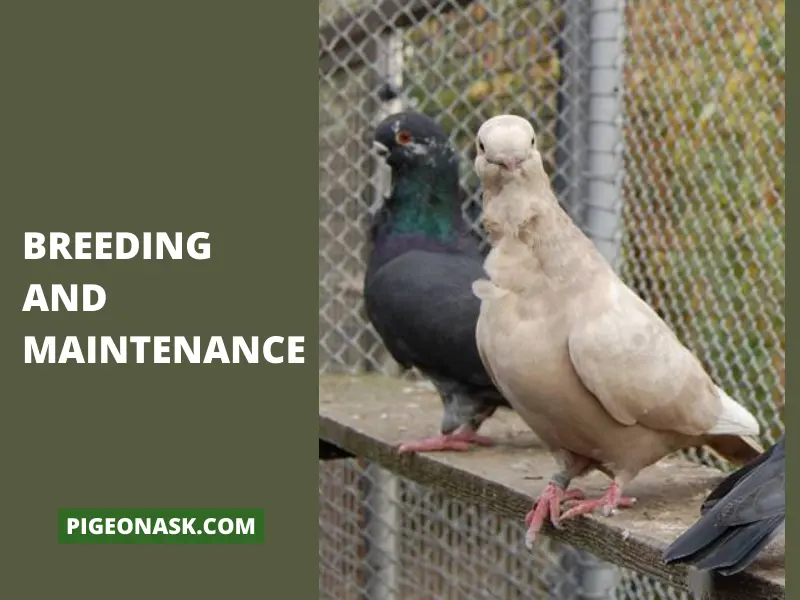
However, these are sensitive and gentle pigeon breeds. So, you won’t get successful broods unless the conditions are right.
African Pigeon Owl Housing Requirements
The ideal pigeon loft gives each bird an airspace of eight to ten cubic feet. A smaller loft might hinder the African Owl Pigeon’s flight capability. You should build nest boxes in the loft for the pairs to sleep at night.
Your pigeon house should get plenty of fresh air. However, you should seal any cracks that might let in chilling winds. Cold and dampness are some of the main concerns while raising these birds since they easily catch respiratory infections.
During the daytime, the loft should receive plenty of sunlight. Lack of sunlight will profoundly affect the pigeon’s hormonal and reproductive health. You can use a 100-watt bulb to light up the loft during winter or in short daytime regions.
The African Owl Pigeon isn’t a danger to other breeds. However, the more aggressive breeds might attack or compete with them. Therefore, it’s best to keep the pigeons separated.
To ensure the best health of your pigeons, clean the loft regularly. Remove droppings and feathers from the nest boxes every day to prevent dampness. You can disinfect the loft and nest boxes once a week with a mild bleach solution.
African Owl Pigeon Diet
The African Owl Pigeon prefers a standard diet. It primarily consists of seeds, grains, nuts and greens. The birds also require some animal protein for optimal development.
Sunflower, safflower, oats, millet and wheat are some of these pigeons’ best seeds and grains. For healthy fats, add peanuts and almonds to the diet.
Mealworms should take care of the animal protein.
Spinach, kale, broccoli, carrot tops, and other similar leafy vegetables are essential in the African Owl Pigeon’s diet. They provide the birds with important vitamins and minerals. Thus making them appear vibrant and colorful.
You can crush oyster shells and charcoal together to make grit. This will help with your pigeon’s digestion. The birds require clean, fresh water all day round. You can serve it in a bowl or water dispenser.
Commercial pigeon feeds can also serve fine. Don’t serve them salty or processed foods. Onion, garlic, avocado and caffeine can be toxic to your pigeons.
How to Breed African Pigeon Owls?
The first condition for a successful brood is privacy. And the birds will mate multiple times in the few days preceding the female laying eggs. So, they need to be separated from other birds.
Once the female lays eggs, both parents will participate in incubation. The eggs usually hatch on the 17th to 19th day or towards the end of the third week.
For the first four to five days, the parents will feed the hatchlings exclusively on crop milk. The hatchlings start on solid foods like seeds towards the end of the first week.
However, the parents continue feeding the nutritious crop milk for up to 14 days.
The hatchlings start showing feathers around the tenth day. Usually, it takes about six weeks for them to fully leave the nest.
Here are a few tips to get the desired results with breeding –
- Choose healthy partners with the same desired traits and characteristics.
- Avoid inbreeding, and do not crossbreed with other pigeon breeds.
- Keep the breeding pair in a place where they would be undisturbed for a few days.
- Covering the cage or nest with a cloth might be helpful if you are short on space. There should still be plenty of natural light around.
- If you’re raising multiple breeds, put identification bands on the African Owl Pigeon’s hatchlings.
- Due to their beaks’ shape, these parents are not good feeders. You might have to assist in feeding the hatchlings seeds and water. Use spoons and syringes for this.
Conclusion
The African Owl Pigeon is a high-maintenance breed and requires commitment. These aren’t sturdy pigeons like racing or feral breeds. They won’t breed or survive long unless you provide the proper setting.
However, fans of the birds’ aesthetic elegance can easily find the motivation to go through with it. Plus, successfully breeding these pigeons can help bring in a few extra dollars each year.
So, that’s all for this discussion. If you find this helpful, share the knowledge with others online. And follow our Facebook, X and Pinterest pages for more content like this one.
